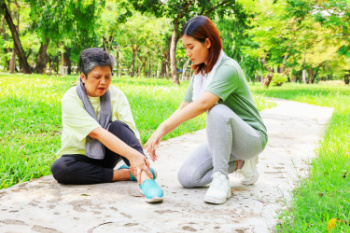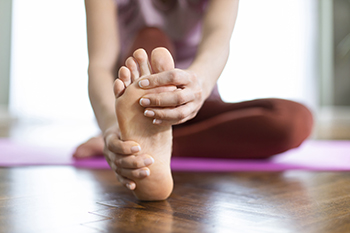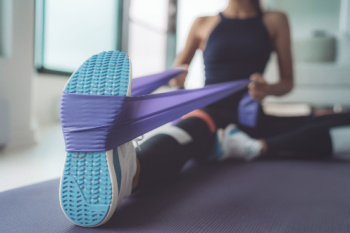Items filtered by date: December 2024
Types of Ankle Sprains in Basketball

Basketball players frequently experience ankle sprains due to the physical demands of the sport. The most common type is a lateral ankle sprain. This type of ankle sprain occurs when the foot rolls inward, a movement called inversion, which stretches or tears the ligaments on the outer side of the ankle. High ankle sprains, though less common, are more severe. This ankle sprain involves the syndesmosis, a group of connective tissues that holds the tibia and fibula bones together just above the ankle. High ankle sprains are caused by a twisting motion that separates these bones. Medial ankle sprains occur when the foot rolls outward, termed eversion, which stresses the deltoid ligament on the inside of the ankle. All types of ankle sprains can cause swelling, pain, and instability. A podiatrist can order digital imaging tests to determine the type of sprain, assess its severity, and create a treatment plan to restore ankle function. If you have ankle pain after playing basketball, it is suggested that you schedule an appointment with a podiatrist for an exam, diagnosis, and treatment options.
Ankle and foot injuries are common among athletes and in many sports. They can be caused by several problems and may be potentially serious. If you are feeling pain or think you were injured in a sporting event or when exercising, consult with Brock Liden, DPM from Ohio. Our doctor will assess your condition and provide you with quality foot and ankle treatment.
Common Injuries
The most common injuries that occur in sporting activities include:
- Achilles Tendonitis
- Achilles Tendon Rupture
- Ankle Sprains
- Broken Foot
- Plantar Fasciitis
- Stress Fractures
- Turf Toe
Symptoms
Symptoms vary depending upon the injury and in some cases, there may be no symptoms at all. However, in most cases, some form of symptom is experienced. Pain, aching, burning, bruising, tenderness, tightness or stiffness, sensation loss, difficulty moving, and swelling are the most common symptoms.
Treatment
Just as symptoms vary depending upon the injury, so do treatment options. A common treatment method is known as the RICE method. This method involves rest, applying ice, compression and elevating the afflicted foot or ankle. If the injury appears to be more serious, surgery might be required, such as arthroscopic or reconstructive surgery. Lastly, rehabilitation or therapy might be needed to gain full functionality in the afflicted area. Any discomfort experienced by an athlete must be evaluated by a licensed, reputable medical professional.
If you have any questions please contact our office located in Circleville, OH . We offer the newest diagnostic and treatment technologies for all your foot and ankle needs.
Ankle Pain Caused by Arthritis

Ankle pain is often a symptom of arthritis, with osteoarthritis, rheumatoid arthritis, and gout being some of the leading causes. Osteoarthritis occurs when the protective cartilage in the ankle joint breaks down, causing pain, stiffness, and swelling. Rheumatoid arthritis, an autoimmune condition, causes inflammation in the joints, leading to pain and limited mobility. Gout, a type of arthritis caused by a buildup of uric acid crystals, often affects the ankle, causing sudden, intense pain and redness. Arthritis in the ankle can significantly impact daily activities, making walking or standing difficult. Over time, untreated arthritis can lead to joint deformities, further restricting movement. Treatment for arthritis-related ankle pain typically includes taking anti-inflammatory medications, targeted exercises, and lifestyle changes like weight management. In more severe cases, surgery may be necessary. A podiatrist can accurately diagnose the type of arthritis and create a personalized treatment plan to manage pain and improve mobility. If you are experiencing ankle pain from arthritis, it is suggested that you schedule an appointment with a podiatrist.
Ankle pain can be caused by a number of problems and may be potentially serious. If you have ankle pain, consult with Brock Liden, DPM from Ohio. Our doctor will assess your condition and provide you with quality foot and ankle treatment.
Ankle pain is any condition that causes pain in the ankle. Due to the fact that the ankle consists of tendons, muscles, bones, and ligaments, ankle pain can come from a number of different conditions.
Causes
The most common causes of ankle pain include:
- Types of arthritis (rheumatoid, osteoarthritis, and gout)
- Ankle sprains
- Broken ankles
- Achilles tendonitis
- Achilles tendon rupture
- Stress fractures
- Bursitis
- Tarsal tunnel syndrome
- Plantar fasciitis
Symptoms
Symptoms of ankle injury vary based upon the condition. Pain may include general pain and discomfort, swelling, aching, redness, bruising, burning or stabbing sensations, and/or loss of sensation.
Diagnosis
Due to the wide variety of potential causes of ankle pain, podiatrists will utilize a number of different methods to properly diagnose ankle pain. This can include asking for personal and family medical histories and of any recent injuries. Further diagnosis may include sensation tests, a physical examination, and potentially x-rays or other imaging tests.
Treatment
Just as the range of causes varies widely, so do treatments. Some more common treatments are rest, ice packs, keeping pressure off the foot, orthotics and braces, medication for inflammation and pain, and surgery.
If you have any questions please feel free to contact our office located in Circleville, OH . We offer the newest diagnostic tools and technology to treat your foot and ankle needs.
Metatarsalgia and Toe Pain

Metatarsalgia is characterized by pain and inflammation in the ball of the foot, often radiating into the toes. It occurs when excessive pressure is placed on the metatarsal bones, which bear much of the body’s weight during walking or running. High-impact activities, improper footwear like high heels or unsupportive shoes, foot deformities, or conditions such as arthritis or bunions can contribute to the development of metatarsalgia. The pain, often described as sharp, aching, or like walking on pebbles, can extend to the toes due to the close proximity of nerves and tissues. To manage metatarsalgia, rest, switch to supportive footwear with cushioning, and use insoles or padding to redistribute pressure. If pain persists, it is suggested that you consult a podiatrist for further evaluation and treatment to prevent the worsening of symptoms.
Toe pain can disrupt your daily activities. If you have any concerns, contact Brock Liden, DPM of Ohio. Our doctor can provide the care you need to keep you pain-free and on your feet.
What Causes Toe Pain?
Most severe toe pain is caused due to a sports injury, trauma from dropping something heavy on the toe, or bumping into something rigid. Other problems can develop over time for various reasons.
Toe pain can be caused by one or more ailments. The most common include:
- Trauma
- Sports injury
- Wearing shoes that are too tight
- Arthritis
- Gout
- Corns and calluses
- Hammertoe
- Bunions
- Blisters
- Ingrown toenails
- Sprains
- Fractures (broken bones)
- Dislocations
When to See a Podiatrist
- Severe pain
- Persistent pain that lasts more than a week
- Signs of infection
- Continued swelling
- Pain that prevents walking
Diagnosis
In many cases the cause of toe pain is obvious, but in others, a podiatrist may want to use more advanced methods to determine the problem. These can range from simple visual inspections and sensation tests to X-rays and MRI scans. Prior medical history, family medical history, and any recent physical traumatic events will all be taken into consideration for a proper diagnosis.
Treatment
Treatments for toe pain and injuries vary and may include shoe inserts, padding, taping, medicines, injections, and in some cases, surgery. If you believe that you have broken a toe, please see a podiatrist as soon as possible.
If you have any questions please contact our office located in Circleville, OH . We offer the newest diagnostic and treatment technologies for all your foot and ankle needs.
Where Do Seed Corns Appear?

Seed corns refers to small, hard bumps or growths that appear on the surface of the skin, usually on the toes or feet. These bumps are typically caused by pressure and friction, often from poorly fitting shoes or repeated movement. Seed corns form when the skin responds to irritation by thickening and hardening to protect the underlying tissue. The condition is common in individuals who engage in activities that put excessive pressure on the feet, such as walking or running long distances. Seed corn can also develop in areas where shoes cause constant rubbing, such as the tops of toes or along the side of the foot. While these growths are usually harmless, they can become painful if left untreated, making it important to address the cause and reduce the friction that leads to their formation. If you have developed a seed corn, it is suggested that you consult a podiatrist who successfully can treat this condition, and offer you effective prevention methods.
If you have any concerns regarding your feet and ankles, contact Brock Liden, DPM of Ohio. Our doctor will treat your foot and ankle needs.
Corns: What Are They? and How Do You Get Rid of Them?
Corns can be described as areas of the skin that have thickened to the point of becoming painful or irritating. They are often layers and layers of the skin that have become dry and rough, and are normally smaller than calluses.
Ways to Prevent Corns
There are many ways to get rid of painful corns such as wearing:
- Well-fitting socks
- Comfortable shoes that are not tight around your foot
- Shoes that offer support
Treating Corns
Treatment of corns involves removing the dead skin that has built up in the specific area of the foot. Consult with Our doctor to determine the best treatment option for your case of corns.
If you have any questions, please feel free to contact our office located in Circleville, OH . We offer the newest diagnostic and treatment technologies for all your foot care needs.
Let the Expert Treat Your Ingrown Toenails
Running Injury Prevention Tips

Preventing running injuries involves a combination of strategies focused on safe progression and proper technique. One key approach is to increase mileage gradually, allowing the body to adapt to the demands of longer distances without overwhelming muscles and joints. This gradual increase reduces the risk of overuse injuries like stress fractures or tendinitis. Proper running form is also essential to minimize strain on the body. Maintaining an upright posture, landing with a midfoot strike, and avoiding overstriding can reduce the impact on your knees, hips, and lower back. Additionally, incorporating smarter workouts, such as cross-training, strength exercises, and rest days, helps balance the repetitive nature of running. A well-rounded training routine allows muscles to recover, build strength, and improve flexibility, further reducing the risk of injury. If you have endured a foot or ankle injury while running, it is suggested that you confer with a podiatrist who can offer treatment solutions, and guide you on additional injury prevention techniques.
All runners should take extra precaution when trying to avoid injury. If you have any concerns about your feet, contact Brock Liden, DPM of Ohio. Our doctor will treat your foot and ankle needs.
How to Prevent Running Injuries
There are a lot of mistakes a runner can make prior to a workout that can induce injury. A lot of athletes tend to overstretch before running, instead of saving those workouts for a post-run routine. Deep lunges and hand-to-toe hamstring pulls should be performed after a workout instead of during a warmup. Another common mistake is jumping into an intense routine before your body is physically prepared for it. You should try to ease your way into long-distance running instead of forcing yourself to rush into it.
More Tips for Preventing Injury
- Incorporate Strength Training into Workouts - This will help improve the body’s overall athleticism
- Improve and Maintain Your Flexibility – Stretching everyday will help improve overall performance
- “Warm Up” Before Running and “Cool Down” Afterward – A warm up of 5-10 minutes helps get rid of lactic acid in the muscles and prevents delayed muscle soreness
- Cross-Training is Crucial
- Wear Proper Running Shoes
- Have a Formal Gait Analysis – Poor biomechanics can easily cause injury
If you have any questions, please feel free to contact our office located in Circleville, OH . We offer the newest diagnostic and treatment technologies for all your foot care needs.

